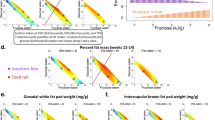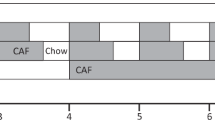Abstract
Objectives:
Rats subjected to a free-choice high-fat high-sugar (fcHFHS) diet persistently overeat, exhibit increased food-motivated behavior and become overtly obese. Conversely, several studies using a non-choice (nc) high-energy diet showed only an initial increase in food intake with unaltered or reduced food-motivated behavior. This raises the question of the importance of choice in the persistence of hyperphagia in rats on a fcHFHS diet.
Subjects:
Meal patterns, food intake and body weight gain were studied in male Wistar rats on free-choice diets with fat and/or sugar and in rats on nc diets with fat and sugar (custom made with ingredients similar to the fcHFHS diet).
Results:
Rats on a ncHFHS diet initially overconsumed, but reduced intake thereafter, whereas rats on a fcHFHS diet remained hyperphagic. Because half of the sugar intake in the fcHFHS group occurred during the inactive period, we next determined whether sugar intake during the light phase was a necessary requirement for hyperphagia, by restricting access to liquid sugar to either the light or dark period with unlimited access to fat and chow. Results showed that hyperphagia occurred irrespective of the timing of sugar intake. Meal pattern analysis revealed consumption of larger but fewer meals in the ncHFHS group, as well as the fcHF group. Interestingly, meal number was increased in all rats drinking liquid sugar (whether on a fcHFHS or a fcHS diet), whereas a compensatory decrease in meal size was only observed in the fcHS group, but not the fcHFHS group.
Conclusion:
We hereby show the importance of choice in the observation of fcHFHS diet-induced hyperphagia, which results in increases in meal number due to sugar drinking without any compensatory decrease in meal size. We thus provide a novel dietary model in rats that mimics important features of human overconsumption that have been ignored in rodent models of obesity.
This is a preview of subscription content, access via your institution
Access options
Subscribe to this journal
Receive 12 print issues and online access
$259.00 per year
only $21.58 per issue
Buy this article
- Purchase on Springer Link
- Instant access to full article PDF
Prices may be subject to local taxes which are calculated during checkout




Similar content being viewed by others
References
Hall KD, Heymsfield SB, Kemnitz JW, Klein S, Schoeller DA, Speakman JR . Energy balance and its components: implications for body weight regulation. Am J Clin Nutr 2012; 95: 989–994.
Buettner R, Scholmerich J, Bollheimer LC . High-fat diets: modeling the metabolic disorders of human obesity in rodents. Obesity 2007; 15: 798–808.
van den Heuvel JK, van Rozen AJ, Adan RA, la Fleur SE . An overview on how components of the melanocortin system respond to different high energy diets. Eur J Pharmacol 2011; 660: 207–212.
la Fleur SE, Vanderschuren LJ, Luijendijk MC, Kloeze BM, Tiesjema B, Adan RA . A reciprocal interaction between food-motivated behavior and diet-induced obesity. Int J Obes 2007; 31: 1286–1294.
la Fleur SE, Luijendijk MC, van Rozen AJ, Kalsbeek A, Adan RA . A free-choice high-fat high-sugar diet induces glucose intolerance and insulin unresponsiveness to a glucose load not explained by obesity. Int J Obes 2011; 35: 595–604.
Mercer JG, Archer ZA . Putting the diet back into diet-induced obesity: diet-induced hypothalamic gene expression. Eur J Pharmacol 2008; 585: 31–37.
Woods SC, Seeley RJ, Rushing PA, D’Alessio D, Tso P . A controlled high-fat diet induces an obese syndrome in rats. J Nutr 2003; 133: 1081–1087.
Davis JF, Tracy AL, Schurdak JD, Tschop MH, Lipton JW, Clegg DJ et al. Exposure to elevated levels of dietary fat attenuates psychostimulant reward and mesolimbic dopamine turnover in the rat. Behav Neurosci 2008; 122: 1257–1263.
Shin AC, Townsend RL, Patterson LM, Berthoud HR . ‘Liking’ and ‘wanting’ of sweet and oily food stimuli as affected by high-fat diet-induced obesity, weight loss, leptin, and genetic predisposition. Am J Physiol Regul Integr Comp Physiol 2011; 301: R1267–R1280.
Giesen JC, Havermans RC, Douven A, Tekelenburg M, Jansen A . Will work for snack food: the association of BMI and snack reinforcement. Obesity 2010; 18: 966–970.
Rollins BY, Dearing KK, Epstein LH . Delay discounting moderates the effect of food reinforcement on energy intake among non-obese women. Appetite 2010; 55: 420–425.
Farley C, Cook JA, Spar BD, Austin TM, Kowalski TJ . Meal pattern analysis of diet-induced obesity in susceptible and resistant rats. Obes Res 2003; 11: 845–851.
Melhorn SJ, Krause EG, Scott KA, Mooney MR, Johnson JD, Woods SC et al. Acute exposure to a high-fat diet alters meal patterns and body composition. Physiol Behav 2010; 99: 33–39.
Warwick ZS, Synowski SJ, Rice KD, Smart AB . Independent effects of diet palatability and fat content on bout size and daily intake in rats. Physiol Behav 2003; 80: 253–258.
Berg C, Lappas G, Wolk A, Strandhagen E, Toren K, Rosengren A et al. Eating patterns and portion size associated with obesity in a Swedish population. Appetite 2009; 52: 21–26.
Berteus FH, Torgerson JS, Sjostrom L, Lindroos AK . Snacking frequency in relation to energy intake and food choices in obese men and women compared to a reference population. Int J Obes 2005; 29: 711–719.
Chapelot D . The role of snacking in energy balance: a biobehavioral approach. J Nutr 2011; 141: 158–162.
la Fleur SE, van Rozen AJ, Luijendijk MC, Groeneweg F, Adan RA . A free-choice high-fat high-sugar diet induces changes in arcuate neuropeptide expression that support hyperphagia. Int J Obes 2010; 34: 537–546.
Tiesjema B, Adan RA, Luijendijk MC, Kalsbeek A, la Fleur SE . Differential effects of recombinant adeno-associated virus-mediated neuropeptide Y overexpression in the hypothalamic paraventricular nucleus and lateral hypothalamus on feeding behavior. J Neurosci 2007; 27: 14139–14146.
van der Zwaal EM, Luijendijk MC, Evers SS, la Fleur SE, Adan RA . Olanzapine affects locomotor activity and meal size in male rats. Pharmacol Biochem Behav 2010; 97: 130–137.
Zorrilla EP, Inoue K, Fekete EM, Tabarin A, Valdez GR, Koob GF . Measuring meals: structure of prandial food and water intake of rats. Am J Physiol Regul Integr Comp Physiol 2005; 288: R1450–R1467.
Furnes MW, Zhao CM, Chen D . Development of obesity is associated with increased calories per meal rather than per day. A study of high-fat diet-induced obesity in young rats. Obes Surg 2009; 19: 1430–1438.
Hariri N, Thibault L . Dietary obesity caused by a specific circadian eating pattern. Chronobiol Int 2011; 28: 216–228.
Warwick ZS, McGuire CM, Bowen KJ, Synowski SJ . Behavioral components of high-fat diet hyperphagia: meal size and postprandial satiety. Am J Physiol Regul Integr Comp Physiol 2000; 278: R196–R200.
Lucas F, Ackroff K, Sclafani A . High-fat diet preference and overeating mediated by postingestive factors in rats. Am J Physiol 1998; 275 (Pt 2): R1511–R1522.
Apolzan JW, Harris RB . Differential effects of chow and purified diet on the consumption of sucrose solution and lard and the development of obesity. Physiol Behav 2012; 105: 325–331.
Martire SI, Holmes N, Westbrook RF, Morris MJ . Altered feeding patterns in rats exposed to a palatable cafeteria diet: increased snacking and its implications for development of obesity. PLoS One 2013; 8: e60407.
Almiron-Roig E, Flores SY, Drewnowski A . No difference in satiety or in subsequent energy intakes between a beverage and a solid food. Physiol Behav 2004; 82: 671–677.
Pan A, Hu FB . Effects of carbohydrates on satiety: differences between liquid and solid food. Curr Opin Clin Nutr Metab Care 2011; 14: 385–390.
Pendergast JS, Branecky KL, Yang W, Ellacott KL, Niswender KD, Yamazaki S . High-fat diet acutely affects circadian organisation and eating behavior. Eur J Neurosci 2013; 37: 1350–1356.
Kohsaka A, Laposky AD, Ramsey KM, Estrada C, Joshu C, Kobayashi Y et al. High-fat diet disrupts behavioral and molecular circadian rhythms in mice. Cell Metab 2007; 6: 414–421.
Avena NM, Hoebel BG . A diet promoting sugar dependency causes behavioral cross-sensitization to a low dose of amphetamine. Neuroscience 2003; 122: 17–20.
Avena NM, Bocarsly ME, Hoebel BG . Animal models of sugar and fat bingeing: relationship to food addiction and increased body weight. Methods Mol Biol 2012; 829: 351–365.
Acknowledgements
This research was supported by The Netherlands Organization for Scientific Research (ZonMw VIDI 917.96.331). We thank F Diemer for technical assistance and Professor Dr MF Dallman for critically reading the manuscript.
Author information
Authors and Affiliations
Corresponding author
Ethics declarations
Competing interests
The authors declare no conflict of interest.
Additional information
Supplementary Information accompanies this paper on International Journal of Obesity website
Supplementary information
Rights and permissions
About this article
Cite this article
la Fleur, S., Luijendijk, M., van der Zwaal, E. et al. The snacking rat as model of human obesity: effects of a free-choice high-fat high-sugar diet on meal patterns. Int J Obes 38, 643–649 (2014). https://doi.org/10.1038/ijo.2013.159
Received:
Revised:
Accepted:
Published:
Issue Date:
DOI: https://doi.org/10.1038/ijo.2013.159
Keywords
This article is cited by
-
Exploring the link between hedonic overeating and prefrontal cortex dysfunction in the Ts65Dn trisomic mouse model
Cellular and Molecular Life Sciences (2023)
-
Polyvinylpyrrolidone-Curcumin Nanoconjugate as a Biocompatible, Non-toxic Material for Biological Applications
Journal of Cluster Science (2023)
-
Early unhealthy eating habits underlie morpho-functional changes in the liver and adipose tissue in male rats
Histochemistry and Cell Biology (2022)
-
The endocannabinoid system is modulated in reward and homeostatic brain regions following diet-induced obesity in rats: a cluster analysis approach
European Journal of Nutrition (2021)
-
Metabolically healthy obese and metabolic syndrome of the lean: the importance of diet quality. Analysis of MAGNETIC cohort
Nutrition Journal (2020)



